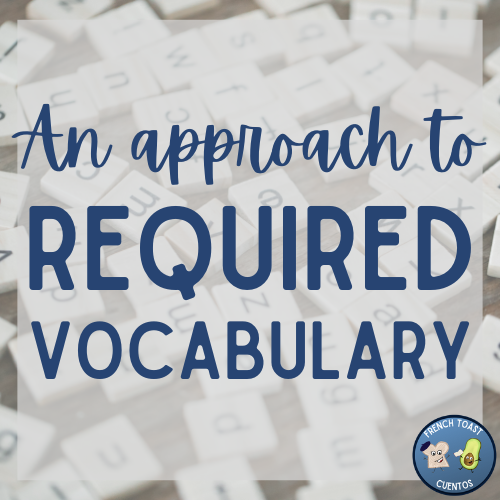Assessment in a CI Classroom
“But, I don’t know French!”
I used to hear this from students ALL. THE. TIME. especially during a test. Students had matched their vocabulary, conjugated their verbs, and then they got to the section where they had to write some sentences using those verbs and vocabulary. They couldn’t do it, they couldn’t put it together. I felt so frustrated because that was what all of the flashcards and worksheets were supposed to be adding up to - actually getting to use the language. I hated assessments. They took me forever to create and to grade, and they felt very disconnected for me and my students in our shared goal of being able to use and understand the language.
This is where Acquisition-Driven Instruction, Comprehensible Input, and aligning my assessments to my goals for students came into the picture.
What does an assessment look like?
Now, in my classroom, assessments are designed to reflect what I actually want to students to be able to do - use the language. Each unit culminates in a three-part assessment comprising of a reading, listening, and writing task. These assessments are scaffolded to align with students' evolving proficiency levels.
At the beginning of the year, students tackle shorter reading passages, identifying key details such as dates, weather conditions, and emotions. As the year progresses, assessments become more comprehensive, requiring students to analyze longer texts, extract main ideas, and delve deeper into character descriptions and settings. Each student has a portfolio where they keep their assessments to track their growth over their French career.
Writing tasks mirror these progression levels, with students expected to incorporate increasingly detailed elements into their compositions and being able to write more complex sentences rather than words and phrases.
These assessments do take a few days to complete. I could have a shortened reading and listening and do them both in one day but I don’t want the students to feel rushed. I want them to feel like they have the time needed to do their best so I plan for one task a day and a makeup day so they can work on any part they didn’t finish. Since these are bigger assessments I do them far less often than I used to do traditional assessments but I end up with about the same number by the end of the year.
Ideally, I would have all three assessments for every unit so we could really see their growth over the year but the reality is sometimes we don’t have time. My 8th graders were finishing up learning about regions of France. I was planning on having at minimum a reading and listening assessment, in addition to a culture test on the facts they actually learned. But then we ended up with two snow days (in APRIL!). I was worried about finishing before they were gone for two weeks to D.C. and then April vacation. I decided to cut the listening assessment and move the culture test until after vacation. That way I could make sure all students had finished at least the reading. I’ll make sure the next assessment includes a listening and writing to balance out their skills.
How do you grade?
My school uses competency-based grading practices, utilizing a four-point scale where a score of three indicates meeting the competency. I use Rubrics to grade student performance based on the criteria of the unit.
In reading assessments, students are evaluated based on their ability to extract main ideas and provide detailed descriptions. While some errors are expected in writing, the focus lies on content rather than mechanical accuracy. Students receive credit for conveying meaning effectively, even if minor errors are present.
Each part of the assessment - reading, listening and writing - gets it's own grade, like each was a separate test. That way we can see how students are progressing in each area of communication. For example, are they a strong reader but struggling to write? Are they all struggling with listening so we need to do more listening practice in class or does my assessment need work? It also helps to balance out their overall grade if they do struggle in one area.
What About Speaking Assessments?
Novice learners face a lot of anxiety with speaking assessments, so I've don’t grade students on spoken proficiency in lower-level classes. Instead, I integrate speaking practice into low-anxiety activities, providing valuable opportunities for oral communication without the pressure of assessment to keep their affective filter low. While I believe speaking assessments may have a place in advanced levels, I prefer to prioritize creating a supportive environment that nurtures students' speaking skills without adding undue stress. It is also incredibly difficult to manage a class of 6th graders while trying to give an individual speaking assessment so I give myself a break there.
To conclude
Assessments in the World Language classroom serve as checkpoints for students' language acquisition progress. By emphasizing task-based evaluations, competency-based grading, and a supportive approach to speaking practice, I can effectively measure student growth while fostering a positive learning environment conducive to language acquisition. My assessments now feel more connected to the way I teach and I feel that students buy into the importance. I feel I am really able to see my students’ language growth now that I assess in this way. They feel more natural and realistic to tasks they would have in the real world. They’re easier and faster to create and to grade. And the best part, I don’t hear “But, I don’t know French!” anymore.
shop here: CI Cuentos Store Madame French Toast
Join our Facebook group here: French Toast Cuentos World Language Collaboration
















